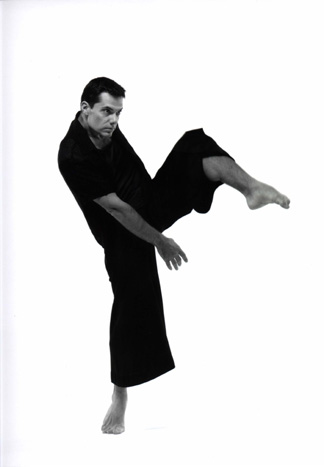Relationship Problems
The
Men's Project
Dance Place
Washington, D.C.
March 20, 2004
by
Tehreema Mitha
copyright 2004 by Tehreema Mitha
published 21 March 2004

Did the program, though, fulfill the needs of the audience? Is modern dance doing that as a whole? Are we seeing unpredictable choreography?
Both the dancers and the dances on the March 20th program varied widely in quality. While some dances were an intensive class in partnering, as was Title Unknown by Paul Gordon Emerson (Reginald Cole is a dancer who should have more dances made for and on him), others went in for the shock value, like David Dorfman’s piece Depth of Perception in which dancer Sharon Mansur takes hilarious liberties with Boris Willis’s body, while he shows remarkable restraint in his touching of her…the reason for which they were unable to explain to audience members in the question and answer session that followed the performance. The dialogue in Dorfman’s dance was witty, entertaining and fun. The movement sections were exquisitely rendered by the two dancers, who slid into the other so that difficult steps were not done as if to say, “Look at me, how good I am!” Yet, as in more than one dance, if you put all the text together leaving all the vast movement linked to itself, one could make two plausible dances. Together they had no connection.
Dad’s Letter, choreographed and performed by Peter DiMuro, was a very personal rendition of memories of his father that had more to do with his image of his father’s movements than what he had written. Questioned later by an audience member as to how one would ever be able to pass on such a role to another dancer, DiMuro said he would expect the new dancer to write out his own script and rework the whole piece. What, I wondered, would happen if this as yet fictional dancer had a father who never wrote? Or a mother who was just as uncommunicative? Would the dance then become about what was not happening?
Paul Gordon Emerson had something similar to say about his piece in which Reginald Cole partnered four different dancers. The dance, originally meant to be about race, became a love duet when danced by a woman and man, and was now presented as a more athletic version because of the ability of the new partner. When a dance gets to the point that every time a new dancer performs the piece it doesn’t just show a subtle shift in rendition or interpretation but its very root meaning changes radically, what it means is that the vessel is empty. This is not something to be held out as a shining example.
Invariably, in each piece (except for Dad’s Letter, which was performed only to spoken voice) there were sections of music put together with gaps of silence. But for the choreographers the stopping and starting of the music seems to hold no meaning. The dancers move within and without the music but the relationship is not one of comfort, or even discomfort; there is no relationship. Visually pleasing, some dances, such as The Smokey Mirror by Melvin Deal, were great photo opportunities with not enough movement to stretch out the time. Stephen Clapp, who choreographed Project Y, and Kevin T. Malone with Ceremonies, Do They Hear You When You Cry, are both dancers with talents to hone and perhaps that is more their field.
While choreographers are dependent and ever in need of well-trained dancers, there are a few dancers who go beyond the dance format and show an ability that would blow away a gymnast. When you have such a dancer in your hands (as Kelly Mayfield), too often the choreographer cannot resist the temptation of showcasing those abilities at every opportunity possible. As long as the audience claps in gasping surprise at each lift, at each contortion, single handstand, totally mesmerized by those beautiful muscles binding the bodies together, it seems, we are on the right path. Let's give them more of what they want. The cycle is vicious and slipping away in between is that which separates dance from a mere technical showcase.
The best ochoreographers have come up after years of training apprenticeship, then find that they have a burning need to say something no one else is saying. Or have a completely new and different way of saying something oft repeated, which strikes a cord with the audience. If neither of the above two reasons presides, what then is the reason to step into the choreographer’s shoes? Being a dancer, one with depth and soul, can be a lifetime mission and one to be cherished in itself. It is a thought worth thinking.
“Powerful” work from “Leading Male Choreographers”? Nurturing takes time. It cannot be a hurried process. That applies to the dance, and both dancers and choreographers.
The Men’s project, Saturday 20th March,, showcasing the works of choreographers Stephen Clapp, Reginald Cole, Melvin Deal, Peter DiMuro, David Dorfman and Paul Gordon Emerson.
Sunday 21st March, Choreography by Daniel Burkholder, Alexander Gish, Jessica Marchant, Jonathan Matis, Alvin Mayes, Tommy Parlon, Chris peck, Ed Tyler, and Douglas Yeuell.
Originally
published:
www.danceviewtimes.com
Volume 2, Number 12
March 21, 2004
©
2004 Tehreema
Mitha
|
|